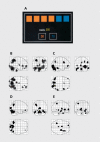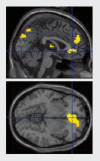Cognitive neuroscience and brain imaging in bipolar disorder
- PMID: 18689286
- PMCID: PMC3181872
- DOI: 10.31887/DCNS.2008.10.2/lclark
Cognitive neuroscience and brain imaging in bipolar disorder
Abstract
Bipolar disorder is characterized by a combination of state-related changes in psychological function that are restricted to illness episodes, coupled with trait-related changes that persist through periods of remission, irrespective of symptom status. This article reviews studies that have investigated the brain systems involved in these state- and trait-related changes, using two techniques: (i) indirect measures of neurocognitive function, and (ii) direct neuroimaging measures of brain function during performance of a cognitive task. Studies of neurocognitive function in bipolar disorder indicate deficits in three core domains: attention, executive function, and emotional processing. Functional imaging studies implicate pathophysiology in distributed neural circuitry that includes the prefrontal and anterior cingulate cortices, as well as subcortical limbic structures including the amygdala and the ventral striatum. Whilst there have been clear advances in our understanding of brain changes in bipolar disorder, there are limited data in bipolar depression, and there is limited understanding of the influence of clinical variables including medication status, illness severity, and specific symptom dimensions.
El trastorno bipolar se caracteriza por la combinación de cambios en la función psicológica estado-dependiente, la que está restringida a los episodios de la enfermedad, y cambios rasgo-dependientes que persisien a través de los períodos de remisión independiente de la sintomatología. En este artículo se revisan estudios que han investigado los sistemas cerebrales involucrados en estes cambios esiado y rasgo-dependienies utilizando dos técnicas: 1) mediciones indirectas de la función neurocognitiva y 2) mediciones directes con neuroimágenes de la función cerebral durante el rendimiento frente a una prueba cognitiva. Los estudios de la función neurocognitiva en el trastorno bipolar revelan déficit en très áreas principales: atención, función ejecutiva y procesamiento emocional. Los estudios de imágenes funcionales incorporan la fisiopatología de circuitos neurales distribuidos en las cortezas prefrontal y del cíngulo anterior, como también de estructuras límbicas subcorticales que incluyen la amigdala y el esiriado ventral. Aunque han existido claras evidencias acerca de nuestra comprensión de los cambios cerebrales en el trastorno bipolar, hay datos limitados para la depresión bipolar, y hay una comprensión reducida de la influencia de variables clínicas como la medicación, la gravedad de la enfermedad y las dimensiones de síntomas específicos.
Les troubles bipolaires sont caractérisés par une association de modifications psychologiques liées à l'état qui sont limitées aux épisodes de la maladie, et de modifications « trait » qui persistent lors des périodes de rémission, indépendamment du statut thymique. Cet article passe en revue les études qui ont utilisé deux techniques pour observer les mécanismes cérébraux impliqués dans ces modifications irait et état dépendantes: 1) des mesures indirectes de la fonction neurocognitive et 2) des mesures directes par neuro-imagerie de la fonction cérébrale pendant l'exécution d'une tâche cognitive. Les études de la fonction neurocognitive dans les troubles bipolaires montrent des déficits dans trois domaines clés: l'attention, les fonctions executives et les processus émotionnels. Les études d'imagerie fonctionnelle impliquent la physiopaihologie de la distribution des circuits neuronaux, dont les cortex cingulaire antérieur et pré frontal, comme celle des structures limbiques sous-corticales, dont l'amygdale et le striatum ventral. Les connaissances sur les modifications cérébrales dans la maladie bipolaire ont bien progressé mais les données sur la dépression bipolaire sont peu nombreuses et l'influence de variables cliniques comme le traitement, la sévérité de la maladie et l'importance des symptômes spécifiques est mal comprise.
Figures


Similar articles
-
Functional magnetic resonance imaging studies in bipolar disorder.CNS Spectr. 2006 Apr;11(4):287-97. doi: 10.1017/s1092852900020782. CNS Spectr. 2006. PMID: 16641834 Review.
-
Affective neural circuitry during facial emotion processing in pediatric bipolar disorder.Biol Psychiatry. 2007 Jul 15;62(2):158-67. doi: 10.1016/j.biopsych.2006.07.011. Epub 2006 Nov 9. Biol Psychiatry. 2007. PMID: 17097071
-
A critical appraisal of neuroimaging studies of bipolar disorder: toward a new conceptualization of underlying neural circuitry and a road map for future research.Am J Psychiatry. 2014 Aug;171(8):829-43. doi: 10.1176/appi.ajp.2014.13081008. Am J Psychiatry. 2014. PMID: 24626773 Free PMC article. Review.
-
An fMRI study of the interface between affective and cognitive neural circuitry in pediatric bipolar disorder.Psychiatry Res. 2008 Apr 15;162(3):244-55. doi: 10.1016/j.pscychresns.2007.10.003. Epub 2008 Feb 21. Psychiatry Res. 2008. PMID: 18294820 Free PMC article.
-
Emotional processing in bipolar disorder: behavioural and neuroimaging findings.Int Rev Psychiatry. 2009;21(4):357-67. doi: 10.1080/09540260902962156. Int Rev Psychiatry. 2009. PMID: 20374149 Review.
Cited by
-
Cognitive Correlates of Borderline Personality Disorder Features in Youth with Bipolar Spectrum Disorders and Bipolar Offspring.Brain Sci. 2025 Apr 10;15(4):390. doi: 10.3390/brainsci15040390. Brain Sci. 2025. PMID: 40309828 Free PMC article.
-
Functional neuroanatomy of mania.Transl Psychiatry. 2022 Jan 24;12(1):29. doi: 10.1038/s41398-022-01786-4. Transl Psychiatry. 2022. PMID: 35075120 Free PMC article. Review.
-
Mendelian randomisation analysis to explore the association between cathepsins and bipolar disorder.BMC Psychiatry. 2024 Oct 31;24(1):758. doi: 10.1186/s12888-024-06210-3. BMC Psychiatry. 2024. PMID: 39482620 Free PMC article.
-
Antagonism between brain regions relevant for cognitive control and emotional memory facilitates the generation of humorous ideas.Sci Rep. 2021 May 21;11(1):10685. doi: 10.1038/s41598-021-89843-8. Sci Rep. 2021. PMID: 34021200 Free PMC article.
-
Identification of the Molecular Events Involved in the Development of Prefrontal Cortex Through the Analysis of RNA-Seq Data From BrainSpan.ASN Neuro. 2019 Jan-Dec;11:1759091419854627. doi: 10.1177/1759091419854627. ASN Neuro. 2019. PMID: 31213068 Free PMC article.
References
-
- American Psychiatric Association. Diagnostic and Statistical Manual of Mental Disorders. 4th ed. Text Revision. Washington, DC: American Psychiatric Association. 2000
-
- Bowden CL. Strategies to reduce misdiagnosis of bipolar depression. Psychiatr Serv. 2001;52:51–55. - PubMed
-
- Ghaemi SN., Ko JY., Goodwin FK. “Cade's disease” and beyond: misdiagnosis, antidepressant use, and a proposed definition for bipolar spectrum disorder. Can J Psychiatry. 2002;47:125–134. - PubMed
-
- Chamberlain SR., Sahakian BJ. The neuropsychology of mood disorders. Curr Psychiatry Rep. 2006;8:458–463. - PubMed
-
- Clark L., Goodwin GM. State-and trait-related deficits in sustained attention in bipolar disorder. Eur Arch Psychiatry Clin Neurosci. 2004;254:61–68. - PubMed
Publication types
MeSH terms
Grants and funding
LinkOut - more resources
Full Text Sources
Medical
